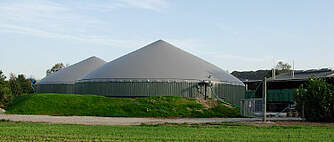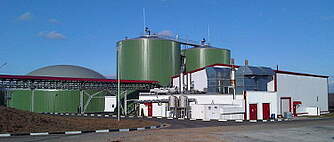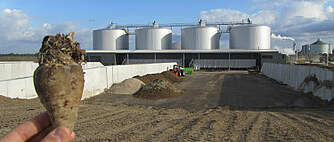Organic industrial residues
In the food industry, for example vegetable and fruit processing, the sugar or potato industry and in slaughterhouses or distilleries, organic substances are generated as residues, and their energy and dry-matter content make them ideal for the generation of renewable energy in biogas plants. However, proficient conceptual design of such plants is necessary in order to tailor the layout and process technology to the consistency and to the impurity or inhibitor content of the residues generated. The design and planning of biogas plants for the fermentation of organic industrial residues is the core competence of Krieg & Fischer Ingenieure GmbH.
A few examples relating to organic industrial waste:
The processing of potatoes generates a variety of residues, from rejected potatoes and potato peelings or segments to potato juice and pulp, right through to starchy waste water. Most potato waste is generated seasonally following the potato harvest.
Reference projects:
- Wietzendorf (Germany): 2002; 8.4 MWel; potato juice, pulp, washing water
- Prinz Edward Island (Canada): 2007; potato waste, oil, starch
- Vierverlaten (Netherlands): 2012; sugar beet fractions and leaves, potato waste
In addition to beet leaves, crowns and ends, the production of sugar also generates other products that work well in biogas plants, such as pressed pulp or vinasse. These substrates are quick-fermenting, therefore they must be accurately dosed.
Reference projects:
- Vierverlaten (Netherlands): 2012; sugar beet fractions and leaves, potato waste
- Dinteloort (Netherlands): 2011; sugar beet silage, vegetable waste (potato, chicory)
- Anklam (Germany): 2012; sugar beet pulp, sugar beet bits, vinasse
In viticulture and in the fruit and vegetable industry, pomace and other fruit residues are generated. These also include difficult-to-ferment waste products from the olive industry or palm oil production. Also, in the case of some fruits or vegetables, inhibitors may be concentrated in the residues, and these must be taken into consideration during decomposition in the biogas plant (citrus fruits, garlic, olives, pomace). In these cases, specific procedures must be employed to eliminate inhibitors and to ensure a balanced supply of nutrients to the biogas plant.
Reference projects:
- Fukuoka (Japan):, 2016/2017; 2 x 1.056 kWel; vegetable waste, residue of shochu, sludge from WWTP, okra, gluten
- Torres de Segre (Spain):, 2012; 2400 kWel; fruit pulp, slaughterhouse sludge, corn silage
- Panama 2009; implementation of a feasibility study concerning the fermentation of banana residues
- Study 2008; statement regarding the fermentation of grape marc
- Study 2003; fermentation of olive waste in Spain
Slaughterhouses also generate residues which can be utilised in biogas plants just like other animal by-products. As well as gastric and intestinal contents, blood, and meat remnants, offal or waste water from the fat separator are also generated to some extent. During fermentation, it is important to ensure a balanced proportion of nutrients and to supplement with other suitable substrates. Depending on the type of waste, the impurity content may also be relevant to the technical process. Please note that there are a large number of country-specific requirements relating to hygiene which must be observed. Depending on the country, hygienisation is required or mandatory for most slaughterhouse waste, however treatment in the biogas plant already contributes to a significant reduction in the bacterial count.
Reference projects:
- JBCE Derby (UK): 2017/2018; biogas upgrading system; hydrolised kitchen cat.2 (viscera)-, paper and cardboard waste (treated by TPH), water (recycled rain, mains)
- Belgorod (Russia): 2011; 2,4 MWel; corn silage, sewage sludge, slaughterhouse waste (offal, fur and hair remnants, meat trimmings) liquid pig manure
- Mc Donnell (Ireland): 2009, 250 kWel, liquid cattle manure, chicken manure, kitchen waste, animal by-products) 250 kWel
- Torres de Segre (Spain): 2012; 2400 kWel; slaughterhouse sludge, maize silage
- Cassa de la Selva (Spain): 2008; 370 kWel, liquid pig manure, slaughterhouse waste, fats, oils
- Serbia 2009; study and preliminary planning of the recommissioning; liquid manure, slaughterhouse waste
- Lecture by Torsten Fischer 2007; Cairns, Australia: 9th International Symposium; Rendering – a flexible resource; Title: Biogas production from gut contents and low value offal
Products such as slop, vinasse or glycerine are generated in distilleries, in breweries, in industrial ethanol production or in biodiesel production, and these can be fermented in the biogas plant with other substrates.
Reference projects:
- Rio Cuarto 2 (Argentina), 2017/2018; 2,927 kWel ;thin stillage, a residual material from ethanol production (Winner of the AD & Biogas World Award 2020)
- Anklam (Germany), 2012; sugar beet pulp, sugar beet bits, vinasse
Waste water is generated during many food industry processes or even municipally, and this can either be purified using specific fermentation processes or can be used for mixing substrates with high dry-matter content. (Fat separator, black water)
Reference projects:
- Os de Balaguer (Spain), 2009; 370 kWel; liquid pig manure, fats, waste water sludge
- Montargull (Spain), 2007; 254 kWel; liquid pig manure, fats, waste water sludge
- Wietzendorf (Germany), 2002; 8.4 MWel; potato juice, pulp, washing water


